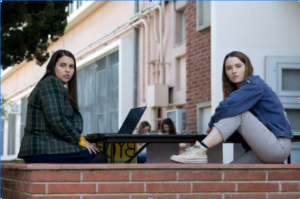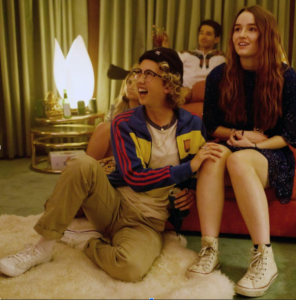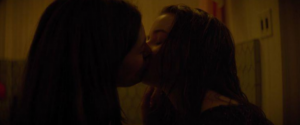91 Booksmart (2019)
Booksmart (2019) and the Lesbian Icon We All Needed
By Annie Rasmussen
Olivia Wilde’s directorial debut, Booksmart (2019) has all the qualities of a hit young-adult comedy. It has quirky characters, a great soundtrack, hilarious escapades, and most importantly an iconic duo played by Kaitlyn Dever and Beanie Feldstein. When Booksmart premiered it was warmly received by many viewers and some even went as far as to name it the “female Superbad”. The film follows two brainy seniors, Amy (Dever) and Molly (Feldstein) on their last night before graduation. The two main characters have played it safe all four years of high school, meaning no parties, no drugs, and no distractions. As valedictorian and salutatorian, and accepted into ivy league schools, their hard work has definitely paid off, but on the last day of school, they come to find out that other people partied and got into those schools as well. This new revelation catalyzes a night full of comical chaos as the two girls make an attempt to live it up for the first time right before their high school journey ends. While the premise sounds fairly typical, it’s the characters that really make the film stand out, one, in particular, is Amy and the LGBTQ+ representation we see with her role.

Amy is an important image of lesbian visibility, especially amongst young people. Amy has been out of the closet since her sophomore year but she has never had any romantic or sexual experiences with another girl. Part of her storyline revolves around her feelings for a girl named Ryan, and her attempt to muster the courage to confess those feelings before the night is over. Her character is refreshing because being a lesbian is part of who she is but it is also just one aspect of the many amazing things about her, and the film makes this very clear. They also show that while a person can be open about their sexual identity, they still can still struggle with being confident in other parts of their expression. By having a character who is out and proud but still navigating romantic and sexual interactions, young queer viewers get to see someone they can connect with in an authentic way.
The topics of difference and LGBTQ+ representation are tied together in the film. With an abundance of heteronormativity in media, it is important to have more stories of LGBTQ+ characters and their relationships. Viewers, regardless of their own identities, should be able to see more queer characters in film and television that reflect the diversity of the real world. An article written by Carly Larsen titled,” Representation of LGBTQ Youth in Education and Media” goes into detail about the lack of representation of LGBTQ+ characters and how there is an even further lack of representation for female members of the community. Larsen writes, “out of the number of LGBTQ characters in inclusive films, gay men appear in 68%, lesbians in 36%, and bisexuals in 14%” (Larsen). The literary design of Booksmart and its depiction of difference makes it stand out in a positive way. Amy’s romantic feelings and storyline are given as much attention and detail as Molly’s feelings for a boy. Oftentimes in media, queer storylines are pushed to the side to shine more light on straight characters, but this is not the case with Booksmart as Wilde embraces the differences between the two main characters equally.

The equality between Amy and Molly’s storylines also plays into the topic of power in the film. Quality representation in any form empowers the group it is representing. When one group is consistently underrepresented, it can give the idea that they aren’t as valuable, leaving the represented group in a superior position. This is a big reason why Booksmart stood out to me. Having a film where the main character is a lesbian high school student that is out of the closet is extremely uplifting and empowering because it is a quality representation that is unfortunately difficult to come by.
The way queer women’s sexualities are portrayed is a necessary topic in the discussion of LGBTQ+ representation and empowerment in film. Lesbian characters are often conventionally attractive, promiscuous, and hypersexual. There’s nothing wrong with having characters with these traits but those traits shouldn’t be tied to the fact the person is a lesbian. In an essay titled, “Lesbian Perceptions of Stereotypical and Sexualized Media Portrayals” the author, Laura Ramsey states, “qualitative findings revealed that lesbians found media portrayals mostly negative and stereotypical, in that they were hypersexualized and for the male gaze, with lesbian relationships portrayed as temporary” (Ramsey). This concept goes along with the idea of power and discrimination in film because when the portrayal of queer women is catered to meet the standards of straight men, it is putting the control in their hands. Accurate representations of queer experiences such as what we see with Amy are actually uplifting to the queer community.
Towards the end of the film, there is a scene that takes place in a party bathroom where Amy has her first sexual encounter ever with a classmate named Hope. It starts with a random passionate kiss initiated by Amy and as things get more intense, we see a realistic depiction of an intimate moment. The two girls struggle to untie their shoes and unbutton their pants, Amy lacks some confidence as she doesn’t really know what to do, and the interaction ends when Amy accidentally takes a sip out of a cup filled with cigarette butts and then vomits all over Hope. While the ending might have been a little dramatic for comedic effort, the scene felt like a very genuine depiction of sexuality. It didn’t feel like it was being thrown in for the sake of having a sex scene or to please the male gaze. This scene is also intertwined with difference and power because as the only sex scene in the film, it forces viewers to reflect on heteronormative expectations.

On another hand, it could be argued that Amy’s experience with Hope feels like a negative representation of lesbian sexuality. This girl isn’t the person she has had feelings for throughout the film and it’s a very temporary relationship. I would argue against that, as this very PG-13 scene felt natural and endearing and was important for Amy’s character development. The fact that it wasn’t an overly romantic encounter doesn’t make it any less valid, in fact, it felt more true to real life. Plus, at the end of the movie, we see that a relationship between the two could be possible in the future.
The final aspect that should be discussed is the topic of LGBTQ+ discrimination and how that is connected to the film. So many queer storylines revolve around the adversities and discrimination that queer people face. These stories are definitely important and it is necessary for them to have a place in film but Booksmart strays away from this. In the film, we don’t see Amy really face any discrimination for her identity. She has been out for a couple years, we don’t see her getting bullied or harassed in any way, and her parents are very accepting. Amy talks a little bit about discrimination against gay people when she tells Ryan that she is volunteering in Botswana for a year and how people like her in other parts of Africa would be killed. Obviously, in America Amy will face plenty of discrimination as it is a white patriarchal society but it is nice to have a lesbian character whose storyline doesn’t revolve around the hardships of her identity.
I still vividly remember the day I saw Booksmart in the theater. Just like the characters in the film, I was a high school senior about to graduate soon. I absolutely loved the film and I remember leaving the theater with my friend with such a warm feeling because I felt seen. Film has been a comfort I’ve turned to for as long as I can remember, finding myself in characters and their stories. As a young, queer woman it took me a long time to find stories that connected with that part of me. I felt like so many representations of queer women relied heavily on sexual experiences and not what it was like to be a queer person. It didn’t feel like those stories were really made for people like me. Seeing Amy in Booksmart was so refreshing because her experiences of being a young queer woman were relateable. It didn’t feel like they were made just to be a visual device for the male gaze. Amy was the first character that made me feel so validated and secure. In an interview with People magazine to promote the film, Beanie Feldstein who is also queer, said, “I think if I could have seen our film earlier, I would have found myself a bit sooner”(Murphy). This is exactly why this film means so much to me.
Like me, so many viewers loved this film because they were able to see pieces of themselves in it. Movies are important because the people and the stories we see are what we assume are reflective of real life. When people hardly ever see representations of themselves and their communities on the big screen, they start to feel like the world doesn’t see them either. This is why films like Booksmart are so important. LGBTQ+ teens deserve to see characters that are openly expressing themselves and proud of who they are. Queer and lesbian women deserve well-developed characters that aren’t just there to promote harmful stereotypes. We need more movies like Booksmart and more characters like Amy.
References
Annati, Arienne, and Laura R. Ramsey. “Lesbian Perceptions of Stereotypical and Sexualized Media Portrayals.” Sexuality & Culture, vol. 26, no. 1, Feb. 2022, pp. 312–38. EBSCOhost, doi.org/10.1007/s12119-021-09892-z.
Helen Murphy and Carly Breit May 22, 2019 03:39 PM. “Beanie Feldstein Says Being Queer Is ‘Just Part of Who I Am’: ‘It’s Not My Defining Feature’.” PEOPLE.com, https://people.com/movies/beanie-feldstein-says-sexuality-not-her-defining-feature/.
Larson, Carly. “Representation of LGBTQ Youth in Education and Media.” Grant Larson Productions, Grant Larson Productions, 13 May 2021, https://www.grantlarsonproductions.com/blog/representation-of-lgbtq-youth-in-education-and-media.
Wilde, Olivia,, et al. Booksmart. Beverly Hills, Calif.: 20th Century Fox Home Entertainment, 2019. DVD.
Image credits
Molly (Feldstein) on the left and Amy (Dever) on the right. Citation: Geisel, Natalie. “Molly and Amy .” The Thirbly, https://www.thethirlby.com/camp-thirlby-diary/2019/6/7/booksmarts-amy-is-the-lesbian-teen-representation-ive-wanted-my-entire-life. Accessed 14 Mar. 2022.
Ryan (Ruesga) and Amy (Dever) watching a karaoke performance at the party. Citation: Geisel, Natalie. “Ryan and Amy.” The Thirbly, https://www.thethirlby.com/camp-thirlby-diary/2019/6/7/booksmarts-amy-is-the-lesbian-teen-representation-ive-wanted-my-entire-life. Accessed 14 Mar. 2022.
Hope (Silvers) and Amy (Dever) Booksmart (2019). Citation: McCormick, Jason. “Hope and Amy.” Flim, https://beta.flim.ai/dop/SmFzb24gTWNDb3JtaWNr?wa=true. Accessed 14 Mar. 2022.

